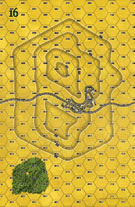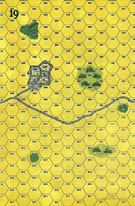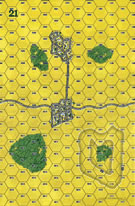|
Quiet Sector Road to Berlin #21 |
||
|---|---|---|
|
(Attacker)
Germany
(Attacker) Hungary |
vs | Soviet Union (Attacker) |
| Formations Involved | ||
|---|---|---|
| Germany |  |
6th Panzer Division |
| Hungary |  |
23rd Infantry Brigade |
| Soviet Union |  |
46th Guards Tank Brigade |
| Soviet Union |  |
4th Guards Mechanized Brigade |

|
| Overall Rating, 2 votes |
|---|
|
3.5
|
| Scenario Rank: --- of 940 |
| Parent Game | Road to Berlin |
|---|---|
| Historicity | Historical |
| Date | 1945-01-23 |
| Start Time | 08:00 |
| Turn Count | 24 |
| Visibility | Day |
| Counters | 155 |
| Net Morale | 0 |
| Net Initiative | 1 |
| Maps | 4: 16, 18, 19, 21 |
| Layout Dimensions | 112 x 43 cm 44 x 17 in |
| Play Bounty | 135 |
| AAR Bounty | 165 |
| Total Plays | 1 |
| Total AARs | 2 |
| Battle Types |
|---|
| Meeting Engagement |
| Urban Assault |
| Conditions |
|---|
| Off-board Artillery |
| Scenario Requirements & Playability | |
|---|---|
| Road to Berlin | Base Game |
| Introduction |
|---|
|
To help meet the German attack around Szekesfehervar, the Soviet 4th Ukrainian Front pulled back its troops at several points along the line. The Germans and Hungarians followed up slowly. When Soviet scouts identified elements of a panzer division advancing on Bicske, a key junction on the road to Budapest, the front command decided not to take any chances. Strong armored forces were ordered to restore the positions abandoned the night before. |
| Conclusion |
|---|
|
The 6th Panzer Division had been ordered to detach all of its remaining tanks to the divisions making the main attack to the south, and the attachment of three battalions from a shattered Hungarian division did not compensate for the lost fighting power. A handful of tanks conveniently listed as "under repair" remained with the division, and the motley force gave a surprisingly good account of itself and actually held onto some of its gains. |
| AFV Rules Pertaining to this Scenario's Order of Battle |
|---|
|
| 5 Errata Items | |
|---|---|

|
The reduced direct fire value of the Heer HMG became 5-5 starting with Fall of France. (plloyd1010
on 2015 Jul 31)
|

|
The morale and combat modifiers of German Sergeant #1614 should be "0", not "8". (Shad
on 2010 Dec 15)
|

|
All SPW 251s have an armor value of 0. (Shad
on 2010 Dec 15)
|

|
The movement allowance on the counters in Airborne is misprinted. It should be "3." (rerathbun
on 2012 Jan 30)
|

|
Kommissars never get morale or combat modifiers. Ignore misprints. (Shad
on 2010 Dec 15)
|
| A not so quiet sector | ||||||||||||||
|---|---|---|---|---|---|---|---|---|---|---|---|---|---|---|
This battle was played Ftf over three sessions. The scenario at first galnce appears to be a meting engagement between Soviet Guards units and a mixed force of German and Hungarien troops. In fact a quick glance at the maps,VC and OOBs will soon indicate that the Axis forces will be on the defensive fairly quickly. The Soviet decided to launch a major assault aginst one of the two towns in the Axis front lines after winning the early tank duel and this worked reasonably well at first. Having destroyed a Panther and Hezter platoon with liitle loss the Red Army tank commander got cocky and went unsupported against Axis ground troop who in short time eliminated 16+ T34,s. This though was a just a blip and the urban assault very slowly gained ground. The German commander launched a desperate counter attack against Soviet forces and although gaining some inital sucess fell foul of the massed Russian artillery. The Germans pulled back and conceded that the battle was lost. A good scenario this though balanced in favour of the Soviets there is still enough gameplay to keep the Axis player intrested. Well worth a look |
||||||||||||||
| 0 Comments |
| Which Part Of The Sector Is Quiet Herr Oberst ? | ||||||||||||||
|---|---|---|---|---|---|---|---|---|---|---|---|---|---|---|
A Quiet SectorThis scenario asks that the winner control more town hexes than his opponent by game end. When the OB of either side is looked at one may think its going to be a reasonably even slug-out .... Wrong ! The Soviets OBA and frightening array of T34/85's, coupled with plenty of high-moraled guardmen with many leaders plus an initiative advantage means that they are very well-better placed to dictate the pace of the battle. That said, a bad draw of leaders for the Ruskie may well effectively make his force far weaker ? Need to see more replays first. But There Is a Spoiler Clause In the VC's If you knock out twice as many enemy than the side holding most town hexes, then it will be a draw. So though not too sure how one would plan it, try and have the makings of your axis forces being able to launch a counter-attack on any weak part of the enemy should you find yourself trailing in the game. By doing this and destroying part of his army in detail, you may rescue a draw. But beware the Soviet 30 col OBA !! Anyway, here is the AAR of what occurred in our ftf battle. Both the Soviets and Germans had a couple of platoons bivouacked forward in nearby towns. Around 0800 hours both forces began their advance towards each other. This battle would consist of three distinct parts. 0800-1000 : For an hour or so both forces advanced toward contact. The German forces busied themselves occupying the towns with their Hungarian allies holding the northern flank. The Soviet guards meanwhile were advancing in a way rarely seen by axis forces in the past. It was a composed ordered advance. An advance that consisted of plentiful amounts of guard infantrymen with ample enthusiastic leaders, and supported by quality T34/85 tanks. These Russians were advancing with purpose, and with little OBA the Germans could do little to disrupt it. The first clashes commenced around 0915. The T34’s got something of a jump on a Hetzer platoon and their large numbers soon made little work of the German self-propelled guns. In reply, Soviet APC’s and infantrymen were being cut down by the defenders rifles and MG’S supported by what few tanks they possessed. These were bloody exchanges indeed. But as the Soviet steam-roller looked for weak-spots, their tank force was soon able to take out the solitary Panther platoon the Germans had, along with a platoon of Pumas too. Hungarian troopers fell also in the defence but the enemy advance was not being stopped. By 1000 hours the Soviets certainly looked poised to swarm all-over the axis defences with minimal trouble. 1000-1200 : Perhaps sensing an easy advance themselves, the Soviets sent four T34 platoons gaily forward towards the Hungarian positions, crossing the front of the perceived helpless German infantry. Led by one of their braver junior officers, the infantry, with panzerfausts resplendent attacked the enemy armour. It was a complete wipeout as all eight Russian tanks were eliminated. Inspired by this, the Hungarian infantry followed, and though not armed to the extent as their German counterparts, they too succeeded in demolishing eight T34’s. In anger, the Soviet OBA bore down on these upstarts and as a result, a good few infantrymen fell as casualties to this shell storm. But a point had been made. The attack would not be a walkover and so for the following two hours it proved to be the case. Soviet casualties rose as a concerted attack was launched on the most southerly town. Incursions were made, but each street seemed to be tenaciously fought for by the outnumbered and out-gunned German defenders. But the Soviet guards were equally tenacious. Being thrown back time after time they continued to throw in attacks on the town to slowly grind down the enemy. Up in the north, the Hungarian defence line was being pressed back and a stand off there had been reached. By 1200 hours, though the battle was definitely in the control of the Soviets, but they were now being asked far harder questions than in the earlier exchanges. 1200-1330 : The last third of the battle was about the Soviets slowly checking the boxes towards victory. They continued to grind mercilessly in the southern town, but not without a good number of their troops being cut down outside its perimeter. If the axis leader did not want to simply watch a slow defeat occur before him, then he had to do something else. Deciding that the towns would be lost, the Magyar-German forces had no option but to at least counter-attack and inflict as much hurt on the enemy numbers as possible. With this in mind, German infantry left the centrally located town and made an attack towards the forest that was housing the Russian guardsmen facing the Hungarians. As they thrust forward, the Hungarians responded in kind and advanced to the front of the forest. This was initially successful for the first half hour, stretching the Soviet line there and also dishing out some casualties. But once more, at 12.45 hours, the Russian artillery came down and hit the densely grouped German infantry inflicting more casualties. With the southern town still holding out but slowly being whittled down the end was nearly in sight. At 1300 hours, the last aggressive kicks of a losing army were delivered, but within half hour after that, the Soviets had claimed the field with their well delivered and ordered attack. Axis losses came to around 660 men, of which 245 were Hungarian. They also lost 12 tanks and 4 armoured cars. (40 step equivalents) Soviet losses came to about 455 soldiers and 18 Tanks plus 8 armoured cars. They also lost numerous M3’s. (50 step equivalents). |
||||||||||||||
| 0 Comments |

 RtBr020
RtBr020 











































